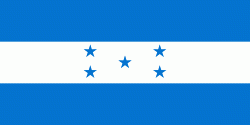Flag of Honduras
The flag of Honduras consists of three equal horizontal stripes of turquoise, white and turquoise, with five turquoise stars in a quincuncial pattern at the centre of the middle stripe. The two outer bands represent the Pacific Ocean and the Caribbean Sea, and also represent the blue sky and brotherhood. The inner band represents the land between the ocean and the sea, the peace and prosperity of its people, and purity of thoughts. The five stars represent the five nations of the former Federal Republic of Central America and the hope that the nations may form a union again.
In 1823, Honduras joined the United Provinces of Central America and adopted its flag. It continued using a plain blue and white triband after the union dissolved in 1838. On 7 March 1866 five blue stars were placed on the flag to represent the five original provinces: El Salvador, Costa Rica, Nicaragua, Honduras, and Guatemala. The size and position of the stars were officially fixed when the design was standardized on 18 January 1949.
The 1949 decree specified that the stripes were to be turquoise, but in practice the flag remained blue for the next seven decades. The Honduran government only began flying turquoise flags after the inauguration of president Xiomara Castro on 27 January 2022, after the National Autonomous University of Honduras made that recommendation in 2021.
Ships of the Honduran Navy fly a naval ensign which has the coat of arms of Honduras above an inverted arch of five small stars and a pendant.
In 1823, Honduras joined the United Provinces of Central America and adopted its flag. It continued using a plain blue and white triband after the union dissolved in 1838. On 7 March 1866 five blue stars were placed on the flag to represent the five original provinces: El Salvador, Costa Rica, Nicaragua, Honduras, and Guatemala. The size and position of the stars were officially fixed when the design was standardized on 18 January 1949.
The 1949 decree specified that the stripes were to be turquoise, but in practice the flag remained blue for the next seven decades. The Honduran government only began flying turquoise flags after the inauguration of president Xiomara Castro on 27 January 2022, after the National Autonomous University of Honduras made that recommendation in 2021.
Ships of the Honduran Navy fly a naval ensign which has the coat of arms of Honduras above an inverted arch of five small stars and a pendant.
National flag
Country - Honduras
Warning: getimagesize(/Image/Map/MP3608932.gif): failed to open stream: No such file or directory in /home/mapnlee7/public_html/MAPNALL/article.php on line 532
 |
 |
Honduras was home to several important Mesoamerican cultures, most notably the Maya, before the Spanish colonization in the sixteenth century. The Spanish introduced Catholicism and the now predominant Spanish language, along with numerous customs that have blended with the indigenous culture. Honduras became independent in 1821 and has since been a republic, although it has consistently endured much social strife and political instability, and remains one of the poorest countries in the Western Hemisphere. In 1960, the northern part of what was the Mosquito Coast was transferred from Nicaragua to Honduras by the International Court of Justice.
